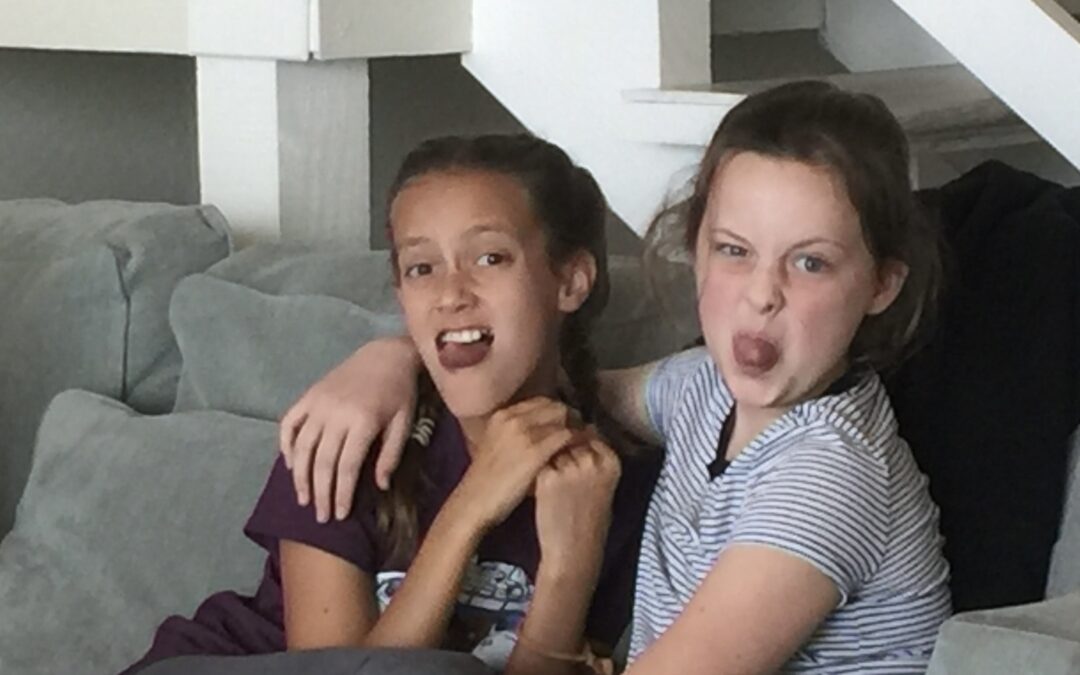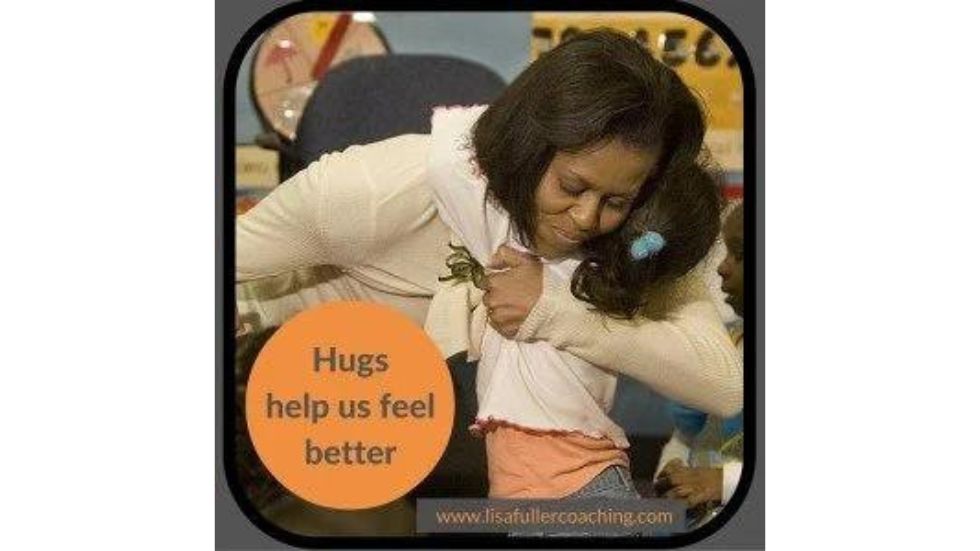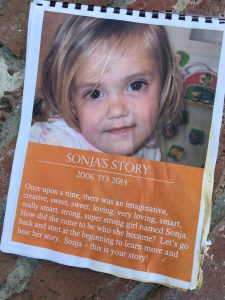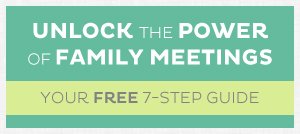
by Lisa Fuller | Feb 27, 2023 | Communication, Connection & Love, Feelings & Emotions, General, Parenting, Self-regulation, teenager
At the end of a recent evening talk, a woman came up and said, “Eighty percent of my relationship with my twelve-year-old daughter is amazing. We’re close and connected, but there’s one thing I’d like to run by you.” Lifting her eyebrows, she confessed, “My daughter’s embarrassed by me!”
The woman continued, “I mean, when I was her age I was embarrassed by my mom, but that was different because my mom WAS embarrassing!”
She rolled her eyes at the irony and we both smiled.
I reassured her, “Your daughter’s embarrassment is normal, and it’s something I’ve experienced regularly from my own sixteen-year-old daughter in recent years. But I can almost promise you she will outgrow it. The best thing you can do is have a sense of humor about it with yourself and with her. If you can hold her criticism lightly and keep laughing, she’ll experience you as a mom who’s strong and grounded in her self worth.
I’m no stranger to the pain and vulnerability that comes with parenting a young teen, so my advice for this parent stems from my continuing to move forward, ego bruises and all!
As I reflected on her question, I thought about how Gretchen Schmelzer describes how trust between parent and child is built through our “endless thereness”:
…. trust is built not because you are loved, but because someone loved you anyway. They loved you when you were angry, or messy, or cranky or a total and complete pain in the ass. They loved you when you forgot, or remembered—when you said it or when you didn’t say it. They didn’t love you because you could do it—they loved you anyway, even when you couldn’t.
As a parent, loving our child despite the hard times is what builds trust. This call for our endless thereness is one reason parenting is so challenging, but it is also why it has the potential to radically change us. Kids give us the opportunity to love another person not because they are always lovable, but because we’ve made the commitment to love them.
We’re there and love our child anyway when:
- we get yet another voice message alert that our child has cut class.
- we learn that our child lied to us about their plans.
- our child climbs on the dining table while we’re trying to share a family meal.
- our child is embarrassed by us, for no good reason 😣
We love them anyway.
Can you relate to this story? Do you have questions? It’s so supportive to know we are not alone! Please share in the comment below.
***. I’m offering an in-person (Sept12) and via Zoom (Sept 14) 7-week parenting series in the East Bay beginning Sept12 and and two 8-week Writing Circles, via Zoom, beginning August 25 & 29.

by Lisa Fuller | Apr 14, 2021 | Communication, Connection & Love, Feelings & Emotions, General, Power struggle, Self-care, Self-regulation, teenager
As I write today I’m reminded of a post I wrote 8 years ago, What I Did When My Daughter Said, “You’re the Boringest and I Hate You! This time, however, it’s not what she said, but instead what she didn’t say and didn’t do that shined a light on some difficult parenting wisdom.
Part I – The Sweater
It all began when I knit my 14 year old daughter a sweater. She’d accompanied me to the store to choose a soft, washable yarn in a neutral color she’d actually wear. During Covid I’ve picked up knitting again and found a healthy distraction in searching for patterns and scrumptious yarns. Because my grandmother taught me to knit when I was young, knitting sent a gentle signal to my brain, “Everything’s okay.”
A couple of weeks ago when I completed the sweater, I laid it on her bed so she’d see it when she got home. I imagined she’d try it on and show me how it fit. Over the past month I’d measured the length of her arms, inquired about how cropped she’d like it as that’s the current fashion and worked to tailor it just for her.
Because she never mentioned the sweater, I checked in with her in the afternoon, “Did you see the sweater? Please try it on — I’d love to see how it fits.”
She answered, “Not right now.”
Later I asked her again and she explained that she’d already changed into her pj’s but that she’d do it the next time she got dressed. The next day I decided to mention it one last time. My heart felt heavy. I didn’t want to get entangled in a power struggle with her over the sweater I’d made for her because I adore her. Needless to say, I never saw it on her.
Part II – The Pile
My daughter had recently cleaned out her room, placing all outgrown and unwanted items into a huge bag in the hall. Beside the bag was a loose pile of papers with a blue glue gun resting on top.
After a few days of watching the pile collect dust, I took a closer look and saw under the glue gun a photo storybook I’d created and given to her for her birthday some years ago.
This project, with a closeup of her soft two year old face on the cover looked to have seen better days. I picked it up and brought it into her room asking, “What’s happened to this?” She confirmed that she’d found it spoiled, likely because last fall she’d placed a little pumpkin from our garden on top of it, in a drawer. The pumpkin decomposed over the course of months.
I felt an anger rise in me and said, ‘You clearly don’t care about it.”
She answered, “I do care.”
I said, “If you cared you’d have come to me when you found it and asked what we could do.” I swore, “Just f***ing get rid of it then, but don’t leave it on the floor for me to take care of.”
Heart pounding, I retreated to my bedroom across the hall where I stood motionless, a little shocked that I’d spoken to her so harshly. Being the youngest child she was adept at avoiding conflict and I’d become more able to keep my cool.
For a split second I thought, I’m going to ignore her, give her the cold shoulder. A memory flashed from the recesses of my mind of my dad ignoring me for two weeks after his feelings had been hurt because I’d been spending weekends at my friend Sharon’s house. I can remember him scolding me as we stood inside our front door, “You care more about her family than you do your own!” I was in 5th grade at the time and it was two weeks before he looked at or spoke to me again.
I decided I wasn’t going to ignore her, even though to hurt her back felt like the “natural” response.
Returning to her room, disintegrating storybook in hand I said, “I realize the reason I’m so upset is that my feelings are hurt. It’s becoming clear to me that you don’t care about things I’ve made for you.”
I was of course thinking about the unadorned sweater.
I repeated myself, “It’s becoming clear to me, and I’m speaking to myself now, that I need to focus less on you and more on myself.”
I felt my voice catch and tears well in my eyes.
Unlike 8 years ago, this time she said nothing. Through the uncared for storybook and forgotten sweater I was getting a message loud and clear, “Mom, get a life. While I need you to be there for me, I don’t need you the same way I used to and I’m not going to act in ways to please you. You haven’t trained me to take care of you and I’m not going to start now. My main concern right now is my friends and all the changes I’m going through. You can’t use me to feel good about yourself.”
I felt grounded when I turned to leave her room, closing the door quietly behind me.
I haven’t figured it all out yet.
It felt valuable to write about and share with you because it’s not spit spat all settled in me and tied up with a bow and maybe you’re having your own messy parenting moments. I’m sitting with a real life collision between my daughter’s age appropriate growth and what I’m gently naming my age appropriate stuckness, a slice of difficult wisdom.
It’s not only children who grow. Parents do too. As much as we watch to see what our children do with their lives, they are watching us to see what we do with ours. I can’t tell my children to reach for the sun. All I can do is reach for it, myself.
— Joyce Maynard

by Lisa Fuller | Jan 21, 2021 | Connection & Love, General, Parenting, Self-regulation, teenager
A white flag signifies to all that an approaching negotiator is unarmed, with an intent to surrender or a desire to communicate. Persons carrying or waving a white flag are not to be fired upon, nor are they allowed to open fire. – wikipedia.org
A few nights ago I was on a Zoom for parents of middle schoolers and an impromptu theme emerged – waving the white flag. One mom shared, that’s it, I’m waving the white flag when it comes to getting the kids to sleep at a decent time. What followed was a cascade of white flag waving.
In addition to bedtime hours, parents shared about letting go of many before time rules including keeping devices out of bedrooms, insistence on family meal times, and enforcing exercise routines. On my computer screen heads in squares were vigorously nodding in recognition. We shared the laughter that comes with the combination of, PARENTING IS SO HARD and I’M NOT THE ONLY ONE.
Being a so called parenting expert (believe me when when I say there’s no such thing), I wondered, “Isn’t there something we want to hold on to? What do we want to prioritize?”
There is something. Connection.
Even though many of us are in the presence of our children now more than ever, that doesn’t necessarily translate to quality bonding time.
On a recent evening, after a typical day of not crossing paths with my 14 year old daughter I told her I missed her and that I felt we hadn’t seen each other in so long. Mistakenly I asked, do you feel that way too? She looked at me, raised her eyebrows and laughed, no… not at all. I’ve seen you a lot mom.
Ouch.
Developmentally this all makes sense. It also makes sense that we’re experiencing this togetherness differently. I can only share what I feel which is intermittent connection and I’ll take it. My mom just shared with me this NYT op ed which brings more context to this story of my daughter. But back to me….
I’ve coached myself to be available (like I did 12 years ago), even when I feel I’ve got something important waiting to be done. For example, inevitably she walks into the kitchen just as I’m leaving and eager to return to a project I’ve got bubbling ideas about.
Stop lisa and stay. Stay here and just be.
So I linger and half the time she actually lights up, betraying that she wants my company. I take what I can get. I plunge my finger into her rice and beans to make sure it’s warm. A huge smile spreads across her face. What I’ve done is so gross and so hilarious that her body leaves the floor as she dances with laughter. Most days I enjoy laughing at myself so I smile not quite able to match her glee.
I’m unarmed, a white flag wrapped around my shoulders.
No two children are the same and you likely have a different dynamic but the constant remains:
Our kids, regardless of age, need us, at times, to hang out, unhurried and casually listening.
How have you experienced quality time during Covid? Have you found new ways to connect? Please share in the comments below. I’d love to hear your story!

by Lisa Fuller | Jul 4, 2017 | Encouragement, General, Parenting, Self-regulation
It’s summer and my daughter and her friend want to go to the pool to play. I fantasize that the girls will occupy each other and I’ll be able to read or at the very least get some knitting done.
Turns out, they want me to join in their amusement. They plead, watch us, watch us as they scheme to perform synchronized, dramatic water jumps and dances.
Quickly it’s apparent that I’ve got three options in how to respond to their pleas:
- Go old school and brush them off saying “No girls, I’m reading.”
- Middle of the road it – “Okay girls – show me what you’ve got” but meanwhile I knit or attempt to read in between requests.
- Go all in with the kids – book closed on the ground, knitting tucked away in its bag – I sit up actually looking directly at them.
Old School
The thought of going Old School on them is familiar and slightly guilt inducing. I grew up with parents and children pretty much doing their own thing, all the time. Sometimes we’d watch football, 6o Minutes or Murder She Wrote on TV together on Sunday evenings (I loved this) but my brother, sister, and I wouldn’t dare to ask directly for attention from grown ups.
It just wasn’t part of the program 40+ years ago. It wasn’t the way our family operated.
There is a time and a place for old school. It’s not only okay, but it’s downright healthy for children to have time when they’re not getting direct attention from an adult.
Here’re two good articles on this topic:
Middle of the Road
Middle of the road is something I know well!
This is the lack of making a conscious decision.
I want to be reading, but my knee jerk parenting shoulding voice says you should be paying attention to the kids Lisa… at all times humanly possible. (Wonder if this is related to the old school way I grew up??? 🙂 )
Then, another part of me says Lisa you’re at the pool, for 3@!$ sake, read your book!
These competing voices are crazy making — nothing is done well with divided attention.
By not making a decision and by default, choosing the middle of the road, you literally split your attention and feel like you’re in No Man’s Land. There’s no upside for yourself or your kid. I see this as the unconscious back drop for many parents these days, particularly with the constant distraction created by our smartphones.
Going All In
Finally, the somewhat novel thought of going all in actually feels like a relief to me when it flashes across my mind as an option.
The me time to do’s (like writing, reading and even knitting) fall away and I feel light, even floaty.
[tweetthis display_mode=”box”]News flash! I can let go and simply focus my full attention in one place.[/tweetthis]
 The girls are asking for me and I decide to let go of the fantasy of me time and watch them like they are qualifying for the Olympics: with my entire being.
The girls are asking for me and I decide to let go of the fantasy of me time and watch them like they are qualifying for the Olympics: with my entire being.
As I do this, my body unwinds into the moment and I feel a tremendous, relaxing sigh throughout my entire being. I only have one task at hand and I can do this and actually do it well.
(I use Headspace to support my on-going meditation practice – I recommend it!)
Having two, much older sons, I know the days of “watch me, mom!” will soon end.
During the next hour I had a singular, beautiful focus. Even now, a year later, it’s a rich memory for me. I can still see the girls’ lit faces, their determination, their playfulness.
Other days I’ve chosen to say “no” and that’s positive, too. It’s healthy for children to see you pursue your interests and to know that they can occupy themselves without your attention.
It’s not an either/or dilemma. We have time in our lives for both.
How often do you find yourself in the middle of the road with your parenting?
The next time you’re in this situation, take a moment to consider where you really want to be and BE THERE instead of staying in the middle.

by Lisa Fuller | Mar 26, 2016 | Communication, Connection & Love, Encouragement, General, Parenting, Self-regulation
Shortly after Eric finished up my 7- week parenting series, he sent me this story which beautifully illustrates the power of asking for a hug.
Last week on my way home from work, my wife Stephanie sent me a text that our daughter Grace (5) was being a handful, was in a horrible mood and that she had had it with her.
When I got home, I walked into the house and went straight to Grace and asked her for a hug. At first she turned her back and crossed her arms, and said no.
I then decided to ask her one more time and after a 5-second pause, she turned and gave me a big hug.
Steph said it was like someone flipped a switch on Grace. She went from being in the worst mood to acting as if she was having the best day ever.
It’s amazing to see the kind of impact and dynamics that something as simple as asking for a hug can have on a 5 year old.
Honestly, before taking your class, I probably would have come home and punished Grace for misbehaving and the entire afternoon would have been ruined for the whole family.
Asking for a hug sounds almost too easy, right? Too simple to be true?
However, while it’s simple… there’s a subtle tweak that’s key to the effectiveness of this parenting strategy.
“I could use a hug” vs. “Can I give YOU a hug?”
The first taps into your child’s deep need for significance and belonging. When you ask for a hug from your child, you acknowledge that they make a difference to you and in fact have a positive influence on your life.
In the later, you are reinforcing what your child hears and perhaps feels frequently: That children need help from grownups to feel better.
The parenting tool of asking for a hug (for YOU) is simple, easy, and effective if done from the perspective of genuine connection, genuine desire for your child to assist you! (Plus, who doesn’t love hugs? I love it!)
Try it out.
Ask a friend to be your parent and say these two phrases to you:
Could you give me a hug?
and
You look like you could use a hug.
Do you notice a difference in how you feel after each?
This week look for an opportunity to ask your child for a hug.
I’d love to hear how it goes in the comments below!

by Lisa Fuller | Apr 26, 2015 | Conflict, General, Parenting, Self-regulation, Sibling Issues
Here’s Part Two of the 3 part Sibling Series: More Good, Less Ugly: Everything you Need to Know to Foster Healthy Sibling Relationships. In case you missed it, you can check out Part One here.
A month ago, after a parent education talk (ironically, NOT about sibling issues), parents came up to me afterwards wanting to ask specific what do I do when questions.
This night each parent had a sibling challenge that deeply distressed them — and they wanted advice on how to work them out — how to FIX them.
After each told me their story of fists, tears, tussles and injustices, I asked, sincerely, so you want this to stop because ________?
It sounds like a joke but I was serious.
Here’s a snippet of their answers (and my thoughts):
- I don’t want my kids to fight. Period. (We get confused thinking peace equals the absence of conflict — not true)
- I’m afraid my children will seriously hurt each other — (it won’t happen if your kids have some skills — it makes sense to focus on teaching these skills).
- I was mistreated and abused by my siblings and my parents did nothing (if you’re reading this post, or trying to understand the issues, you’re not doing nothing. You’re learning how to respond rather than react).
It’s important for you to get to the bottom of your frantic need to end sibling fights.
When you feel desperate, your children tune into your urgency and — baBOOM! — their fights gain greater importance and power.
No matter what age they are, you can see the wheels turning in their mind… “Hey, I’m onto something here — mom’s lost her mind over this bickering — it’s energizing to have her so plugged in so I’m going to persist and/or do it again soon.”
[tweetthis]Even if a child is scared, negative engagement with you is better than the alternative, no connection[/tweetthis]
Your children are wired to get your attention (think survival) and this sibling stuff is just the ticket.
So what if you don’t react when the fight breaks out, and instead acknowledge them by:
- Letting them know you notice what’s going on and you’re here if they need your help (hint: think of yourself as a consultant rather than a cop) or
- Saying, “I can see you’re struggling with each other and I have faith that you’ll be able to work it out together.”
What’ll happen next? They’ll be flabbergasted that you haven’t jumped in to fix or solve.
Jane Nelsen says surprise leads to confusion. When a child is confused because she doesn’t get the reaction she’s used to, she’s ready to consider a new behavior.
- If the surprise results from a respectful interaction, her confusion will include a feeling of belonging and encouragement, so her new behavior is likely to be positive.
- If the surprise is a result of disrespect, then her previous misbehavior is likely to intensify.
After a recent sibling talk I got this email from a mom who’d bravely tried what I’d suggested, the very next morning:
Hi Lisa,
I wanted to tell you my success story from this morning. I feel like one of the examples from the book (Siblings without Rivalry), I was so surprised at its effectiveness!
This morning my 5.5yo son Eden left his favorite transformer toys on the floor, and his 1.5yo sister Lulu ran to them and started playing. He saw that, ran over, and pushed her backwards so her head banged the floor (she’s had worse bumps, but it was still rough and it hurt her).
I calmly went over and said, “Do you two need some help? Lulu doesn’t know why you pushed her. Use your words to tell her. I know you two can work this out. I’m going in the kitchen now so you can work it out.”
I walked away as Lulu whimpered a few times, just sitting next to her brother, probably unsure why I hadn’t defended her better.
Only 5 to 10 seconds after I walked away, Eden said, “Hey Louie, do you want another one?! I’ll get you one!” and jumped up to get her the one transformer he wasn’t playing with. He gave it to her, she happily accepted, and she scooted away a few inches to play with it in her own space.
I COULDN’T BELIEVE IT! It was exactly like the book and you said it would happen! Even though it worked so well, I admit I felt a bit guilty about seemingly abandoning Louie to her big brother in a moment of distress. But I get that their relationship benefitted from his problem-solving so much more than if I had stepped in.
Based on the book, if we can be consistent with this kind of conflict resolution, soon both kids will not feel this as abandonment, but as empowerment instead.
–Rachel
This story beautifully illustrates that [tweetthis]you don’t stop teaching your kids just because you don’t get involved in the moment of conflict.[/tweetthis]
Rachel admits the guilt she felt in trying a new behavior — I think many of us don’t try new tools and responses, even though they may be more effective in the long run, because of the dreaded parent guilt – what’ll happen if it doesn’t work?.
There may be times when you want to step in — how do you do that without fixing?
Here are three Positive Discipline Tools to help in the moment with a dispute between young children:
- DISTRACTION — “I’ll give you something else to do now.”
- SEPARATION — “Let’s move you over here for now.”
- PUTTING KIDS IN THE SAME BOAT and recognizing that CHILDREN DO BETTER WHEN THEY FEEL BETTER — “I’d like to read you both a story now – it will help put us in a good mood. Then you can try to play together again… when you both feel better.”
So often when you plunge into a sibling fight, you think you know what’s going on.
This week, pretend you don’t and put the kids in the same boat.
Do your best to stay out of their business (or consult from the sidelines), and see what happens.
Please share your thoughts in the comments below.
If you’re not already on the list, sign up to receive Part 3 of the Sibling Series: From Squabbles to Sharing: Proven Strategies to Improve Sibling Relationships by email.










